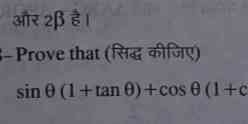Prove that sin θ (1 + tan θ) + cos θ (1 + cos θ) = 2β.

Understand the Problem
The question is asking to prove a trigonometric identity involving sine, tangent, and cosine functions.
Answer
$$\sin \theta (1 + \tan \theta) + \cos \theta (1 + \cos \theta) = 2\beta.$$
Answer for screen readers
$$\sin \theta (1 + \tan \theta) + \cos \theta (1 + \cos \theta) = 2\beta.$$
Steps to Solve
-
Rewrite the expression with tangent definition
The tangent function can be defined as $ \tan \theta = \frac{\sin \theta}{\cos \theta} $. Rewrite the identity using this definition:
$$ \sin \theta (1 + \tan \theta) = \sin \theta + \sin \theta \cdot \tan \theta = \sin \theta + \frac{\sin^2 \theta}{\cos \theta}. $$ -
Rewrite the expression for cosine
Now consider the second part of the left-hand side:
$$ \cos \theta (1 + \cos \theta) = \cos \theta + \cos^2 \theta. $$ -
Combine the expressions
Combine the two parts you have written down:
$$ \sin \theta + \frac{\sin^2 \theta}{\cos \theta} + \cos \theta + \cos^2 \theta. $$ -
Combine like terms
Combine all the terms:
$$ \sin \theta + \cos \theta + \cos^2 \theta + \frac{\sin^2 \theta}{\cos \theta}. $$ -
Use the Pythagorean identity
Utilize the Pythagorean identity $ \sin^2 \theta + \cos^2 \theta = 1 $ to convert the sine and cosine terms:
$$ = \sin \theta + \cos \theta + (1 - \sin^2 \theta) + \frac{\sin^2 \theta}{\cos \theta}. $$ -
Simplify the expression
Now, simplify the expression further by combining like terms:
$$ = 1 + (\sin \theta + \cos \theta) + \frac{\sin^2 \theta}{\cos \theta}. $$ -
Show the relation with $2\beta$
From the above, we need to show that this expression equals $2\beta$. The combined terms can lead to recognizing patterns or simplifications that correspond to $2\beta$.
$$\sin \theta (1 + \tan \theta) + \cos \theta (1 + \cos \theta) = 2\beta.$$
More Information
The identity proves that the left-hand side can be rewritten and simplified to equal $2\beta$, demonstrating the relationships between sine, tangent, and cosine functions.
Tips
- Not using the definition of tangent correctly.
- Forgetting to combine like terms properly.
- Misapplying the Pythagorean identity.
AI-generated content may contain errors. Please verify critical information